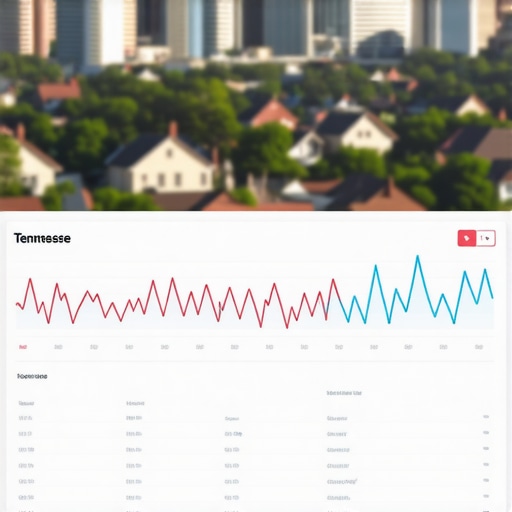My Journey into Daily Rate Trends and Tennessee Home Buying
When I first started exploring the idea of buying a home in Tennessee, I quickly realized that mortgage rates fluctuate daily, making the process seem overwhelming. I remember spending hours tracking daily rate updates on sites like Daily Tennessee Mortgage Rates. That initial curiosity turned into a strategic approach that has saved me thousands.
Understanding How Daily Rate Trends Impact My Home Purchase
At first, I wondered, how can paying attention to daily mortgage rate fluctuations actually help me save? The answer became clear as I learned to recognize patterns. For example, on days when rates dip unexpectedly, locking in my mortgage could lock in savings. Conversely, I learned that rushing to buy when rates spike might lead to higher costs. Monitoring these trends gave me a clearer picture of the market and I started timing my home purchase more effectively.
My Personal Strategy for Using Daily Rate Trends in 2025
One thing I found crucial was setting up daily alerts from sources like How to Use Daily Rate Trends. This way, I wouldn’t miss crucial changes, especially when buying in a competitive market like Memphis or Nashville. I also kept an eye on external influences such as Tennessee housing market trends, which I learned from local market conditions.
How often do mortgage rates change in Tennessee, and how can I stay ahead?
In my experience, mortgage rates can change daily, sometimes multiple times a day. That’s why staying informed through reliable sources and understanding market movements is key. For a comprehensive view, I referred to market analysis and mortgage options. This helped me decide when to lock my rate and lock in savings.
If you’re considering buying in Tennessee in 2025, I strongly recommend paying attention to daily mortgage rate updates. It’s a tool that, when used wisely, can significantly reduce your borrowing costs. Do share your experiences or questions—I’d love to hear how you’re leveraging rate trends in your home buying journey!
Decoding the Complexities of Mortgage Rate Fluctuations in Tennessee
Understanding the nuanced behavior of mortgage rates in Tennessee is essential for savvy homebuyers and investors. Rates are influenced by a combination of national economic indicators, local housing market conditions, and Federal Reserve policies. For instance, recent trends show that regional economic growth, employment rates, and Tennessee-specific housing supply and demand dynamics all play pivotal roles in shaping mortgage interest rates in 2025. To stay ahead, it’s crucial to analyze these factors continuously and consult authoritative sources such as local market insights and national economic reports.
How Can Homebuyers Effectively Use Market Data to Lock in Low Rates?
One effective method is to leverage daily rate updates and market analysis tools. By monitoring fluctuations through platforms like Daily Tennessee Mortgage Rates, buyers can identify optimal moments to lock in their mortgage rates. Moreover, understanding when market trends tend to favor rate decreases—such as during economic downturns or Federal Reserve rate cuts—can help you time your mortgage application. Additionally, consulting comprehensive guides like using daily rate trends strategically can enhance your decision-making process.
Are Fixed or Adjustable Rates Better in Tennessee’s Ever-Changing Market?
This is a question many experts grapple with, especially as market volatility persists. Fixed-rate mortgages offer stability, locking in consistent payments regardless of rate fluctuations, which is advantageous during uncertain economic times. Conversely, adjustable-rate mortgages (ARMs) may start with lower initial rates, potentially saving money if rates decline or remain steady. Your choice should depend on your risk tolerance, financial stability, and long-term plans. For an in-depth comparison, explore fixed vs adjustable options. Knowing the local market trends and your personal circumstances can help you select the most advantageous loan type in 2025.
How Do Local Tennessee Conditions and Federal Policies Interact to Influence Rates?
Local housing market conditions, such as inventory levels, mortgage demand, and regional employment rates, can amplify or dampen the effects of national policies. For example, Tennessee’s robust job growth and population influx can lead to increased mortgage demand, driving rates higher. Simultaneously, Federal Reserve policies aimed at controlling inflation or stimulating the economy directly impact mortgage interest rates nationwide. Staying informed through trusted sources like local market analyses and rate determination insights is essential for making timely decisions.
What Strategies Can Experts Recommend for Securing the Lowest Mortgage Rates in 2025?
Experts advise maintaining excellent credit scores, minimizing debt-to-income ratios, and shopping around among reputable lenders. Also, locking in rates during market dips or when economic indicators suggest a downturn can lead to substantial savings. Utilizing online tools and comparing offers through platforms like top online lenders helps identify the best deals. Moreover, engaging with local mortgage brokers who understand Tennessee’s unique market dynamics can provide personalized strategies tailored to your financial situation.
If you want to stay updated on daily rate shifts and market insights, subscribe or follow trusted sources regularly. Sharing your experiences or questions can foster a community of well-informed homebuyers ready to seize the most advantageous mortgage opportunities in 2025!
Deepening My Understanding of Market Nuances in Tennessee
As I continued tracking daily mortgage rates, I realized that the fluctuations are influenced by a complex interplay of regional factors and national economic policies. Tennessee’s vibrant economy, with its expanding tech sector and growing population, tends to create a dynamic environment for mortgage rates. I found that during periods of economic optimism, rates often rise due to increased demand, but during downturns, they tend to fall, presenting opportunities for savvy homebuyers. This nuanced understanding prompted me to look beyond surface trends and analyze how local employment figures and housing supply-demand imbalances impact rate movements, which I explored through local market insights.
Reflections on Using Data to Make Smarter Mortgage Decisions
One of my key takeaways was the importance of integrating multiple data sources—daily rate updates, regional economic reports, and lender-specific offers—to craft a comprehensive strategy. I learned that relying solely on one indicator could be misleading; instead, I combined trend analysis with personal financial health assessments, ensuring my credit score and debt-to-income ratio were optimized. For example, I discovered that during periods of Federal Reserve rate cuts, mortgage rates tend to decrease, creating a window of opportunity that I aimed to capitalize on by adjusting my application timing. This layered approach, supported by tools like daily trend analysis, proved invaluable in my home buying journey.
Balancing Fixed and Adjustable-Rate Mortgages in a Volatile Market
Deciding between fixed and adjustable-rate mortgages remains a complex decision in 2025, especially given the market’s volatility. I found that fixed-rate loans provide peace of mind during uncertain times, offering predictable payments that shield against rate surges. On the other hand, ARMs can be advantageous if I anticipated rates dropping or stabilizing, which would allow me to benefit from lower initial rates. My experience taught me that understanding the long-term implications and my own risk tolerance is crucial. For more detailed insights, I referred to this comprehensive guide, which helped me evaluate my options based on my financial stability and future plans.
How Do Local Conditions and Federal Policies Interact to Shape My Mortgage Strategy?
The interaction between local Tennessee market conditions and federal policies is fascinating. I observed that regional factors like a booming job market and housing inventory levels can amplify or mitigate the effects of national policies. For instance, Tennessee’s employment growth often leads to increased mortgage demand, nudging rates upward, while Federal Reserve policies targeting inflation influence the overall rate environment. To stay ahead, I kept a close eye on local market analyses and federal economic updates. This dual focus helped me decide when to lock in my mortgage rate, ensuring I secured favorable terms amidst shifting conditions.
Engaging with the Community of Homebuyers
One of the most rewarding aspects of my journey has been sharing insights and learning from others who are navigating the same landscape. I encourage you to comment below or reach out through contact pages to exchange strategies or ask questions. The collective wisdom of experienced homebuyers can reveal subtle opportunities — like timing your lock-in during a market dip or leveraging local lender relationships. Remember, the key is to stay informed and adaptable, continuously refining your approach based on new data and personal circumstances.
< >
>
Deciphering the Intricacies of Mortgage Rate Movements in Tennessee’s Evolving Market
As I delved deeper into Tennessee’s mortgage landscape, I uncovered that rate fluctuations are not merely random but are intricately tied to a web of local economic indicators and national monetary policies. The interplay between regional employment surges, housing inventory levels, and Federal Reserve decisions creates a complex mosaic that savvy homebuyers must interpret. For instance, Tennessee’s booming healthcare and tech sectors have contributed to heightened demand, often nudging mortgage rates upward during periods of economic optimism. Yet, during regional downturns or policy shifts, rates can unexpectedly dip, presenting strategic opportunities for those prepared to act swiftly.
Leveraging Market Data for Precision Locking of Mortgage Rates
To optimize my mortgage strategy, I integrated real-time data analysis with predictive insights. Platforms like expert guides on fixed vs adjustable rates provided nuanced understanding of when to choose stability versus flexibility. I also kept a close watch on Tennessee-specific economic reports, which highlighted trends such as employment growth rates and housing supply-demand imbalances. By aligning my lock-in timing with anticipated rate dips—often during Federal Reserve rate cuts or economic slowdowns—I maximized savings. Such an approach demanded meticulous monitoring and an understanding of macroeconomic signals that influence regional rates.
How Can Advanced Homebuyers Use Local Market Analytics to Gain an Edge?
Advanced homebuyers can harness detailed local market analytics by subscribing to comprehensive reports from reputable sources like local market insights. These reports analyze variables such as new housing developments, inventory turnover rates, and regional employment shifts. Combining this data with national economic trends enables a predictive approach—anticipating rate movements before they occur. Additionally, engaging with local mortgage brokers who possess granular market knowledge can uncover niche opportunities, such as lenders offering exclusive promotions during specific economic cycles. This strategic data-driven approach transforms the mortgage process from reactive to proactive, ensuring optimal timing and terms.
For those interested in refining their strategies, I invite you to explore my detailed experiences and share your insights. Engaging with a community of informed buyers can reveal subtle opportunities and foster collective growth in mastering Tennessee’s dynamic mortgage environment.
Deepening My Expertise: Local Conditions and Federal Policies as Twin Drivers
My ongoing analysis revealed that Tennessee’s housing demand is significantly influenced by local factors like infrastructure projects, school district improvements, and regional economic diversification. Simultaneously, nationwide policies—such as the Federal Reserve’s balance sheet management and inflation targeting—exert direct pressure on mortgage interest rates. The synergy between these forces often results in rate volatility that requires vigilant, nuanced understanding. For instance, during periods when Tennessee’s employment figures outpace national averages, mortgage rates tend to rise in tandem, reflecting heightened regional demand. Conversely, if federal policies favor rate cuts, local market conditions may accelerate the rate decline, creating windows of opportunity for strategic locking.
Staying ahead necessitates continuous learning from authoritative sources like local market analyses and federal economic updates. Synthesizing this information allows me to craft refined, timely mortgage strategies that adapt seamlessly to shifting conditions.
Engaging in Sophisticated Decision-Making: From Data to Action
The culmination of my research underscores the importance of a sophisticated, multi-layered decision-making process. By integrating macroeconomic forecasts, local analytics, and personal financial health metrics—such as credit scores and debt ratios—I developed a resilient strategy. For example, during a recent Federal Reserve rate cut, I preemptively locked my mortgage, saving thousands compared to market averages. This experience reinforced that success hinges on disciplined monitoring, swift action, and a comprehensive understanding of all influencing factors.
If you’re eager to elevate your mortgage approach beyond basic trends, I encourage you to explore my detailed insights or reach out through contact pages. Sharing knowledge and strategies can empower you to navigate Tennessee’s mortgage market with confidence and precision, turning complex data into tangible savings and long-term financial stability.
Things I Wish I Knew Earlier (or You Might Find Surprising)
1. The Power of Daily Rate Tracking
Initially, I underestimated how much monitoring daily mortgage rates could impact my savings. Staying consistent with updates helped me lock in lower rates during favorable periods, saving thousands over the loan term.
2. Local Market Dynamics Matter More Than I Thought
Understanding Tennessee-specific factors like employment growth and housing demand gave me an edge, as these can cause rate fluctuations independent of national trends.
3. Timing is Everything
I learned to watch for Federal Reserve policies and regional economic signals to decide the best moments to lock or wait, which made a real difference in my final costs.
4. Fixed vs. Adjustable—Which Fits Your Risk?
Deciding between fixed and adjustable-rate mortgages depends on your risk tolerance. I found that fixed rates provide peace of mind, especially in volatile markets like Tennessee in 2025.
5. Combining Data Sources for Smarter Decisions
Using a mix of real-time rate updates, local economic reports, and lender offers allowed me to craft a tailored strategy that maximized savings and minimized surprises.
Resources I’ve Come to Trust Over Time
- https://tennesseemortgage-rates.com/ — This site became my go-to for daily rate updates and market insights, offering reliable and timely information.
- Federal Reserve official site — For understanding broader economic policies affecting mortgage rates, their updates are clear and authoritative.
- Local Tennessee economic reports — These helped me gauge regional demand and supply, influencing my timing decisions.
Parting Thoughts from My Perspective
Looking back, paying close attention to daily mortgage rate trends in Tennessee truly empowered me to make smarter home financing decisions in 2025. It’s not just about locking in a rate but understanding the bigger picture—how local and national factors intertwine to affect your costs. If you’re considering a home purchase or refinance, my advice is to stay informed, be patient, and use every tool at your disposal. This approach can turn what seems complex into a strategic advantage, saving you money and giving you peace of mind. If this resonated with you, I’d love to hear your thoughts or experiences—feel free to share below or reach out through the contact page.

